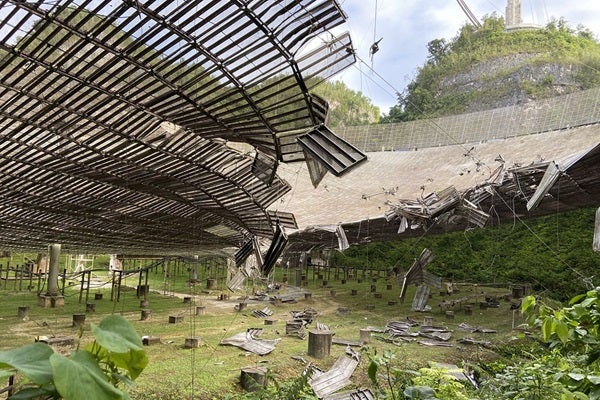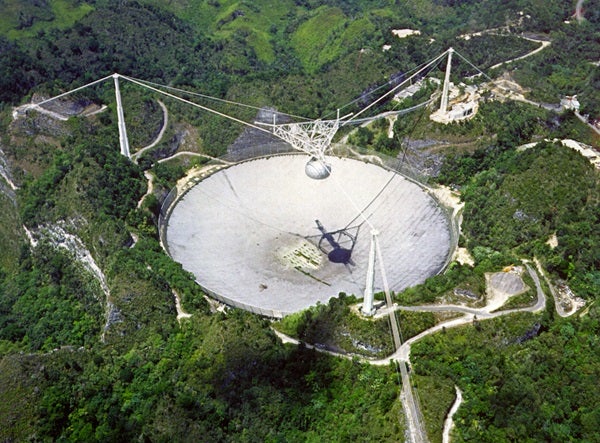The Arecibo Observatory just can’t catch a break.
Early Monday morning, a 3-inch thick cable that supports a platform high above the radio telescope failed, striking and damaging the dome that houses its receiver and tearing a 100-foot (30.5 meter) gash in the observatory’s main dish. No one was injured in the incident, observatory officials say, which occurred at 2:35 A.M. local time while the telescope was tracking, according to a log maintained by Arecibo’s Phil Perillat.
“This was certainly an unprecedented event,” said observatory director Francisco Cordova during a Zoom call with reporters on Friday.
The telescope is offline while Arecibo staff assess the damage. “The last couple of days have really been focused on ensuring the structural integrity of the facility, making sure that the staff continues to be safe,” Cordova said.
What caused this cable to fail is still unknown. The cables were expected to last for another 15 to 20 years, Cordova said. But this one broke with no warning, says Ramon Lugo, the director of the Florida Space Institute at the University of Central Florida (UCF), which co-manages the Puerto Rican facility, in an email to Astronomy. “We have done numerous inspections of the cables following the hurricanes, most recently Isaias, and the multitude of earthquakes we have experienced this year,” Lugo adds. But Cordova did not rule out the possibility that those events could have contributed to the cable failure.
Observatory officials say they are confident the damage will be repaired, but don’t yet have a schedule. “We are starting the peak period of hurricane activity in the Caribbean,” says Lugo, “which is another unknown variable to the timeline.”
Arecibo: A scientific workhorse
The cable failure is the latest setback for the observatory, which had its budget slashed in November 2017 just two months after being struck by category-4 Hurricane Maria. The facility is still repairing Maria-related damage to one of its transmitters. It was also shaken by a swarm of earthquakes at the end of 2019 and early 2020. Then, just this month, Tropical Storm Isaias slammed into the facility. Though, thankfully, these events didn’t cause major damage.
Arecibo, with its 1,000-foot (300-m) dish that spans some 20 acres, is one of the most famous telescopes in the world — featured in movies like the 1997 adaptation of Carl Sagan’s novel Contact (where Jodie Foster uses it to search for alien life) and the 1995 Bond movie Goldeneye (where it explodes and crushes the film’s villain).
Its fame is matched by its scientific reputation: built in 1963, Arecibo remains the second largest radio telescope in the world and continues to be a scientific workhorse. In recent years, it has been overtaken in size by the Five-hundred-meter Aperture Spherical Telescope (FAST) in southwestern China, which is currently being commissioned and calibrated.
But although FAST should surpass Arecibo in receiving capabilities, it isn’t yet able to transmit radio waves as powerfully. By sending radio signals into space, Arecibo acts as a planetary radar that can image potentially hazardous near-Earth asteroids. Plus, it keeps an eye out for other celestial objects. In 2016, it made a major find when it uncovered the first repeating fast radio burst — powerful objects that are among the most mysterious in the cosmos.
Arecibo is also a key member of the NANOGrav project (North American Nanohertz Observatory for Gravitational Waves), which monitors pulsars — spinning stars with huge magnetic fields that produce beams of radiation — hoping to detect gravitational waves that disrupt the metronomic regularity of their sweeps.
The team thinks they are closing in on a detection within the next couple of years, making Arecibo’s damage especially painful, says Scott Ransom, one of NANOGrav’s founders and an astronomer at the National Radio Astronomy Observatory.
“We observe about half of the pulsars in the array with Arecibo, and so we won’t get data on any of them until the telescope is back online. And that is likely to take months and possibly up to a year, maybe longer if there is worse damage than we know,” says Ransom. “So, it could be quite bad for us in the short term. And if the National Science Foundation (NSF) — historically the observatory’s main funder — “decides that it is too expensive to fix, that would be a total disaster,” he adds.
Assessing Arecibo’s damage
The cable that failed is not one of the three main cables that support Arecibo’s receiving platform above the dish. Instead, it’s one of many auxiliary cables installed a little over 20 years ago. When this cable failed, it came out of its socket atop the platform’s southeast supporting tower, which set the entire telescope oscillating for three minutes, according to Perillat’s log. The failure also twisted the platform that’s used to access the dome, according to a statement released by UCF.
On the ground, the scale of the damage to the dish seems immense. But when viewed from above, the wound is relatively small compared to its full size, affecting about 250 of the dish’s roughly 40,000 reflecting panels.
However, what worries some astronomers the most is the state of the sensitive receiving equipment at the telescope’s focus, housed in what’s called the Gregorian dome, which is suspended above the dish. Photos posted by Perillat appear to show tears in several of its panels.
“If it was just the dish [below] that was damaged, you could still receive — it’s just going to be less sensitive because you have less area,” says Yvette Cendes, a radio astronomer at the Harvard–Smithsonian Center for Astrophysics in Cambridge, Massachusetts, and Astronomy contributor. “If something in [the dome] got damage, then that is a very different question,” she says. “And obviously now it’s a question of safely checking all the other cables.”
“If the dome has significant damage or can’t move properly, that could cause much more difficult repairs,” adds Ransom. “It is all quite worrisome.”
Observatory officials are still assessing whether it’s safe for a team to get to the dome for closer inspection, but they aren’t overly concerned about the its overall state. “We don’t expect to find damage inside the Gregorian dome,” Cordova said on Friday. “Certainly, there is damage to the exterior aluminum panels, [but] that was not done to the actual room inside the Gregorian that has all of the critical equipment.”
Arecibo’s lingering funding concerns
Lugo is confident that Arecibo will bounce back. “We have the complete support of both NSF, [which] is responsible for the Observatory, and our NASA stakeholders to make the needed repairs to return to full operational capability,” Lugo told Astronomy in an email, citing verbal conversations and emails.
But exactly how those repairs will be funded remains unclear. “NSF supports Arecibo and the researchers who work there,” said Robert Margetta, a spokesperson for the agency. “We will work with them to assess the next steps forward and address the situation. We cannot comment on potential funding at this time.”
In a statement to Astronomy, NASA said that after UCF assesses the damage to Arecibo, NSF would “consult with stakeholders, including NASA, to determine how to proceed.”
Arecibo has faced a series of existential crises ever since a 2006 NSF review recommended drastic cuts to its funding, or even close the facility in favor of other high-priority astronomy projects. Though scientists and enthusiasts rallied to save Arecibo from this threat, in 2013, NSF began considering selling the facility. Eventually, in 2017, NSF decided to continue funding it, but at a much reduced level — slashing its $8.2-million contribution to Arecibo’s annual $12-million operating budget to just $2 million. This served as a lifeline to allow the facility to seek other sources of revenue.
One such revenue source came in the form of a four-year, $19-million grant from NASA in September 2019. The grant provided funding to continue monitoring potentially hazardous near-Earth objects. That same month, NSF also gave Arecibo $12.3 million to make improvements to the facility, including finishing the repairs from Hurricane Maria. Some astronomers have taken comfort in these recent investments as a hopeful sign that the U.S government is not prepared to walk away from Arecibo anytime soon.
Lugo acknowledges the challenges that the observatory has faced in recent years. But he says the Arecibo team and the local community have both shown resilience and continue to make progress. “This is just another opportunity to show the world that this team can weather the storm.”











